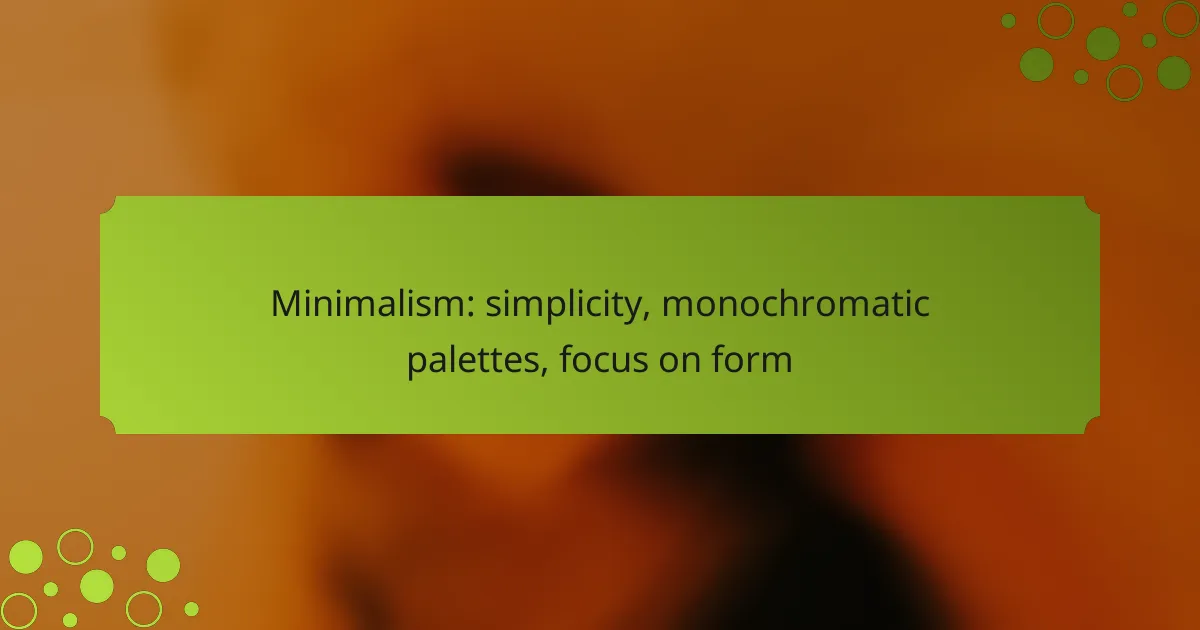Minimalism is an aesthetic that champions simplicity, emphasizing clean lines and a monochromatic color palette to create serene and functional spaces. By prioritizing essential elements and reducing clutter, minimalism fosters an environment that enhances focus and tranquility. This design philosophy is reflected in various brands, such as IKEA, Muji, and Apple, which showcase the beauty of form through their streamlined products and branding.

How to implement minimalism in interior design?
Implementing minimalism in interior design involves creating a space that prioritizes simplicity and functionality. Focus on essential elements, reduce clutter, and choose a cohesive color palette to achieve a serene and organized environment.
Use monochromatic color schemes
Monochromatic color schemes utilize varying shades and tints of a single color to create a harmonious look. This approach simplifies the visual experience and enhances the sense of space, making rooms feel more open and cohesive.
To implement this, select a base color that resonates with your style, then incorporate different shades through furniture, wall paint, and accessories. For example, a soft gray can be paired with darker charcoal and lighter silver accents for depth.
Incorporate functional furniture
Functional furniture serves multiple purposes, which is essential in minimalist design. Opt for pieces that offer storage solutions or can be easily transformed, such as a coffee table that doubles as a storage unit.
Consider furniture with clean lines and simple shapes to maintain a streamlined appearance. Avoid overly ornate designs that can clutter the visual space and detract from the minimalist aesthetic.
Emphasize open spaces
Open spaces are a hallmark of minimalism, promoting a sense of freedom and tranquility. To achieve this, arrange furniture to create clear pathways and avoid overcrowding any area.
Use area rugs to define spaces without physical barriers, and consider removing non-essential walls to enhance flow. This approach not only improves functionality but also allows natural light to permeate throughout the home.
Declutter regularly
Regular decluttering is crucial for maintaining a minimalist environment. Establish a routine to assess belongings and remove items that no longer serve a purpose or bring joy.
Adopt the “one in, one out” rule: for every new item you bring into your home, consider removing one. This practice helps prevent accumulation and keeps your space organized and serene.
Focus on natural light
Natural light enhances the minimalist aesthetic by creating an airy and inviting atmosphere. Maximize daylight by using sheer window treatments and strategically placing mirrors to reflect light.
Consider the orientation of your windows and the layout of your space to ensure that light flows freely throughout. Avoid heavy drapes that can block light and make spaces feel cramped.

What are the benefits of a minimalist lifestyle in Australia?
A minimalist lifestyle in Australia offers numerous benefits, including reduced stress and enhanced focus. By simplifying your environment and possessions, you can create a more peaceful and productive life.
Reduces stress and anxiety
Minimalism helps to reduce stress and anxiety by eliminating clutter and distractions from your surroundings. A tidy space can lead to a clearer mind, allowing you to focus on what truly matters.
In Australia, where urban living can often feel overwhelming, adopting a minimalist approach can create a calming atmosphere. Consider decluttering your home by removing items that no longer serve a purpose or bring joy.
Enhances focus and productivity
By simplifying your environment, minimalism enhances focus and productivity. Fewer distractions allow you to concentrate better on tasks, leading to improved efficiency.
In a work-from-home culture that has gained popularity in Australia, a minimalist workspace can significantly boost your output. Aim to keep your desk clear of unnecessary items and create a designated area for work to help maintain focus.
Promotes sustainability
Minimalism promotes sustainability by encouraging mindful consumption and reducing waste. By purchasing only what you need, you contribute to a more sustainable lifestyle.
In Australia, where environmental concerns are increasingly important, adopting minimalism can help you make more eco-friendly choices. Consider investing in quality, durable items instead of fast fashion or disposable products, which can lead to less waste and a smaller carbon footprint.

Which brands exemplify minimalist design?
Several brands are known for their minimalist design, focusing on simplicity, monochromatic palettes, and a strong emphasis on form. IKEA, Muji, and Apple are prime examples, each embodying these principles in their products and branding.
IKEA
IKEA is renowned for its minimalist approach to furniture and home decor, offering functional designs that prioritize simplicity and affordability. Their products often feature clean lines and neutral colors, making them versatile for various interior styles.
When shopping at IKEA, consider the balance between aesthetics and practicality. Look for items that not only fit your space but also serve multiple purposes, such as storage solutions that blend seamlessly into your decor.
Muji
Muji stands out with its philosophy of “no brand” and a commitment to minimalism in everyday products. Their offerings range from stationery to clothing, all characterized by understated designs and a focus on functionality.
To embrace Muji’s minimalist style, choose products that emphasize quality and simplicity. Avoid clutter by selecting items that serve essential functions without unnecessary embellishments, aligning with the brand’s ethos of simplicity.
Apple
Apple exemplifies minimalist design in technology, with products that feature sleek lines and a user-friendly interface. Their commitment to simplicity is evident in both hardware and software, creating an intuitive experience for users.
When considering Apple products, focus on their seamless integration and minimalist aesthetics. Opt for devices that enhance your daily life without overwhelming you with features, reflecting the brand’s core principle of simplicity in design.

What are the key principles of minimalism?
The key principles of minimalism focus on simplicity, functionality, and prioritizing quality over quantity. This design philosophy emphasizes removing excess to create a more meaningful and aesthetically pleasing environment.
Simplicity
Simplicity in minimalism means stripping away unnecessary elements to highlight essential features. This approach often results in clean lines, uncluttered spaces, and a monochromatic color palette that fosters tranquility.
To achieve simplicity, consider using a limited color scheme, such as shades of white, gray, or beige, and select furniture with straightforward designs. Avoid decorative items that do not serve a purpose, as they can detract from the overall aesthetic.
Functionality
Functionality is a core principle of minimalism, emphasizing that every item should serve a clear purpose. This principle encourages the use of multi-functional furniture and spaces that adapt to various needs.
For instance, a coffee table that doubles as storage or a sofa bed can maximize utility without overcrowding a room. When selecting items, prioritize those that enhance daily living while maintaining a streamlined look.
Quality over quantity
Minimalism advocates for investing in high-quality items rather than accumulating numerous low-quality possessions. This principle not only enhances durability but also elevates the overall aesthetic of a space.
When choosing decor or furniture, focus on timeless designs made from durable materials, such as solid wood or metal. This approach ensures that each piece contributes to the minimalist ethos while standing the test of time.

How to choose a monochromatic palette?
Choosing a monochromatic palette involves selecting one base color and using its various shades and tints to create a cohesive look. This approach emphasizes simplicity and form, allowing for a clean and elegant aesthetic.
Select a base color
The first step in creating a monochromatic palette is to select a base color that resonates with the desired mood or theme. Consider colors that evoke specific emotions; for example, blue can convey calmness, while red may express energy.
When choosing a base color, think about the space or design context. A neutral base, like gray or beige, can offer versatility, while a bold color can serve as a focal point. Test the color in natural and artificial lighting to see how it changes throughout the day.
Incorporate varying shades
Once a base color is selected, incorporate varying shades and tints to add depth and interest. Shades are created by adding black to the base color, while tints are made by adding white. This variation can help define different elements within a space or design.
For instance, if your base color is green, you might use a dark forest green for larger furniture pieces and a light mint for accents. Aim for a range of three to five shades to maintain visual harmony without overwhelming the viewer.
Add texture for depth
To enhance a monochromatic palette, introduce different textures that can create depth and dimension. Textures can be achieved through materials like wood, fabric, metal, or stone, each contributing unique tactile qualities to the overall design.
For example, pairing a matte wall finish with glossy furniture can create an engaging contrast. Consider using textiles such as woven fabrics or plush rugs to add warmth and comfort, ensuring that the overall look remains cohesive while still feeling dynamic.

What are common misconceptions about minimalism?
Many people mistakenly believe that minimalism is synonymous with emptiness or a lack of personality. In reality, minimalism emphasizes simplicity, functionality, and intentionality, focusing on essential elements while maintaining a sense of style and comfort.
Minimalism means living with nothing
A common misconception is that minimalism requires living with almost no possessions. While some minimalists choose to drastically reduce their belongings, the core principle is about keeping only what adds value to your life. This can mean different things for different people, ranging from a few essential items to a curated collection of meaningful objects.
Minimalism is only about aesthetics
Many believe minimalism is solely about visual appeal, but it also encompasses lifestyle choices and mental clarity. A minimalist approach can lead to reduced stress and increased focus by eliminating distractions, whether through a monochromatic color palette in design or decluttering your living space.
Minimalism is expensive
Some think that adopting a minimalist lifestyle requires significant financial investment in high-end, designer items. However, minimalism can be budget-friendly, focusing on quality over quantity. Thrift stores, second-hand shops, and DIY projects can provide affordable ways to achieve a minimalist aesthetic without breaking the bank.
Minimalism is a trend
Many view minimalism as a fleeting trend, but it is a long-term lifestyle choice rooted in intentional living. While trends may come and go, the principles of minimalism—simplicity, functionality, and mindfulness—remain relevant for those seeking a more meaningful existence. Embracing minimalism can lead to lasting changes in how you interact with your environment and possessions.
